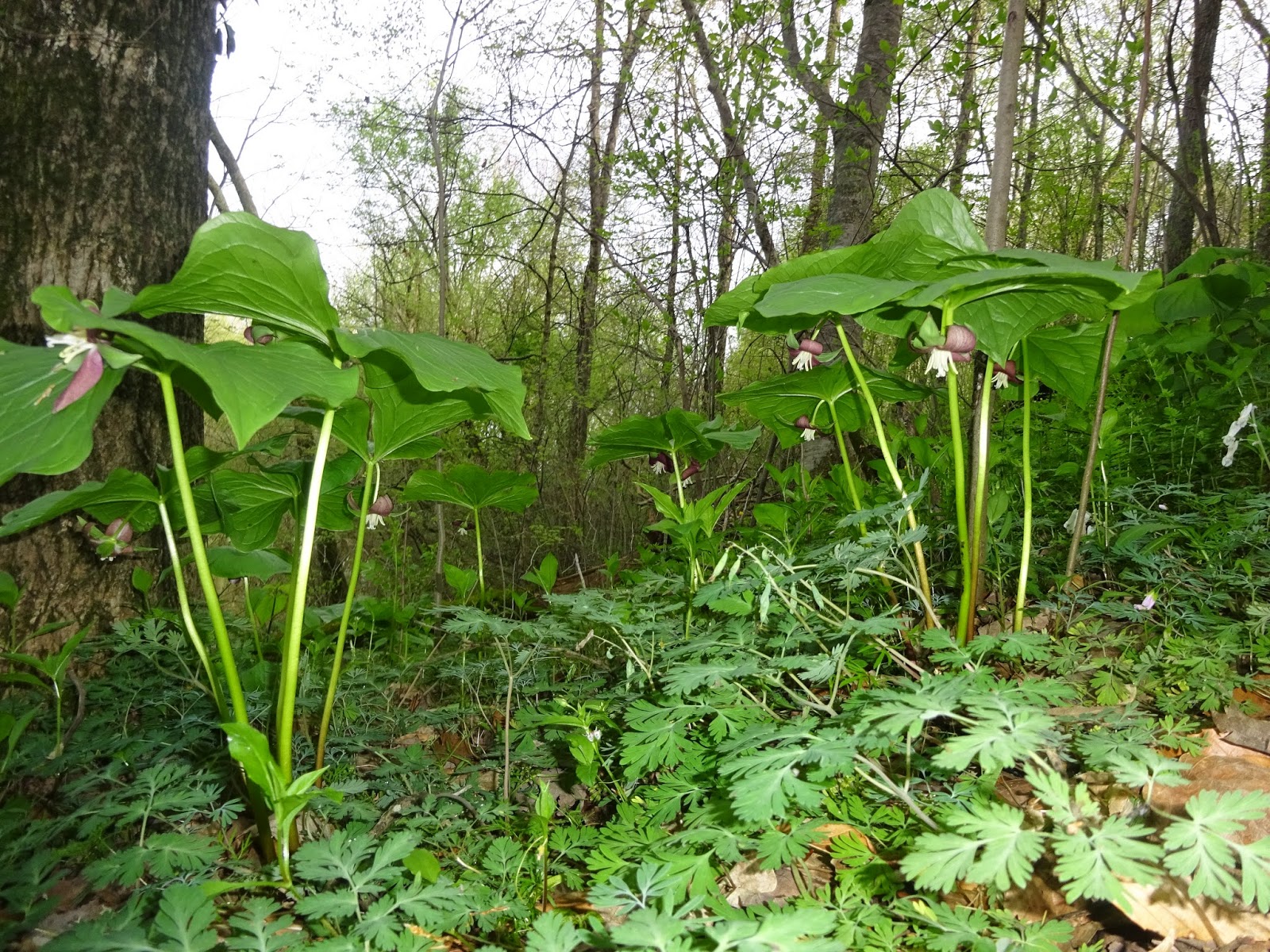A rather portentous visit to one of America's great National Parks--Mammoth Caves. Biggest cave system in the world (300 miles and counting). I was disappointed to find the verges of the path crowded with garlic mustard: with the thousands of daily visitors, surely they could hire a few weeders? The last blog was written at the end of April, but the season was so advanced then that this time we encountered a whole different palette of plants. Part three, you say? The other parts may or may not be forthcoming...it was a fabulous trip that could produce another six blog entries, but the season marches on!
 |
| Saxifraga virginiensis |
This trim saxifrage was on every shady slope. Hundreds of them around the cave--maybe thousands. We found these in several nearby spots--on moist, shady cliffs and slopes.
 |
| Saxifraga viginiensis duking it out with Bignonia capreolata |
 |
| Saxifraga above, Sedum ternatum below. |
 |
| Jack in the Pulpit (Arisaema triphyllum) |
These looked as though they'd just come up!
 |
| Phlox divaricata |
Blue phlox is so variable!
 |
| Julian Campbell alongside escaped Pyrus calleryana |
Bradford pear has escaped into the wild--here are two husky specimens in an abandoned field alongside our guide--the amazing field botanist Julian Campbell who lives in Lexington and travelled with us the last time we visited.
 |
| Gleditsia triacanthos |
Now THOSE are thorns--I wonder if they slowed down the mammoths at all?
 |
| Viola pedata |
We were so fortunate to have Julian, who'd scouted things out. He knows Kentucky like the back of his hand! I've never seen birdsfoot violets looking so perfect before--dozens on the hard, limy clay alongside a road: I always thought they demanded acid soil!
I took this picture to show the variability: two very different seedlings growing next to one another--a giant on the right!
And here was an albino...I was tempted to dig it...
And my favorite of the lot...you can tell I was crazy about these!

Violets growing with pussytoes: the pussytoes are dead easy--why do the violets have to be such a challenge?
 |
| Prunus munsoniana |
One of four wild plums that grow in Kentucky!
 |
| Julian raising cane! |
Several species of native bamboo have been delineated in recent years--this is
Arundinaria gigantea,which grow near streams and can get nearly 20' tall. It burned badly this past cold winter.
 |
| Lithospermum caroliniense |
Another fabulous native: puccoon--which grows all the way to Colorado.
 |
| Prunus americana |
The American plum in Kentucky was more upright and less wicked than our scrubby little things. I love the fragrance on this plant!
 |
| Cercis canadensis |
The redbuds were glorious everywhere in Tennessee and Kentucky: we returned to Denver at the peak of redbud season, and they're glorious for us too. In the East, however, I noticed that they tend to be smaller than ours, and more delicate:
Bonanza: a hillside practically smothered with
Trillium flexipes var
. walpolei (most forms of this species are white flowered.
 |
| Trillium flexipes var. walpolei |
 |
| Dutchmen's briches (Dicentra cucullaria) |
Why does this plant leap over the Rockies and grow in the Columbia River valley in the Palouse prairie of all places. A truely annoying geobotanical riddle, that!
 |
| Isopyrum thalictroides |
This rue-anemone look alike grew in vast mats everywhere in Kentucky as far as I could tell (in moist forests that is). Not many nurseries sell this.
 |
| Jeffesronia diphylla and Stylophorum diphyllum |
These diphylloid endemics of the Midwest are garden classics: but to see them abounding in nature is one of the great pleasures of traveling for me. A plant in wild is worth two in the garden, to maim a cliche.
 |
| Trillium flexipes var. walpolei |
More
flexipes. Sorry....I was smitten!
 |
| More Isophyrum |
 |
| Mertensia virginica |
The bluebells/chiming bells/languid ladies were everywhere. I love this thang (the local twang is getting to me!)
 |
| MORE Mertensia |
 |
| More isopyrum duking it out with Hydrophyllum |
 |
| Phlox divaricata and Polystichum acrostichoides unfurling at right. |
Another wonderful clump of phlox growing with a bevy of cool plants.
 |
| And more Trillium flexipes var. walpolei |
The dang
flexipes was everywhere...here with a choice woodland
Cerastium which makes a great contrast!
 |
| Trillium flexipes var. walpolei |
 |
| Dicentra canadensis |
I was surprised to see squirrel corn growing right next to Dutchman's britches (who says "breeches"?). They look so superficially similar in leaf--but the flowers and co
 |
| Proof I was there! Trillium flexipes var. walpolei |
 |
| Trillium flexipes var. walpolei |
 |
| Our guide, Julian and Trillium flexipes var. walpolei |
 |
| Julian and a cliff... |
Julian not only LOOKS like a sprite, he prances around like a woodland spirit: I've met few keener botanists in my day.
 |
| Asplenium (Camptosorus) rhizophyllum |
And I finish with one of my favorite plants: the walking fern (which refuses to walk for me)...
Thank you, Kentucky, for a fabulous week of plants, generous people and fun. Now back to work (grunt, groan, moan)...





































0 comments:
Post a Comment